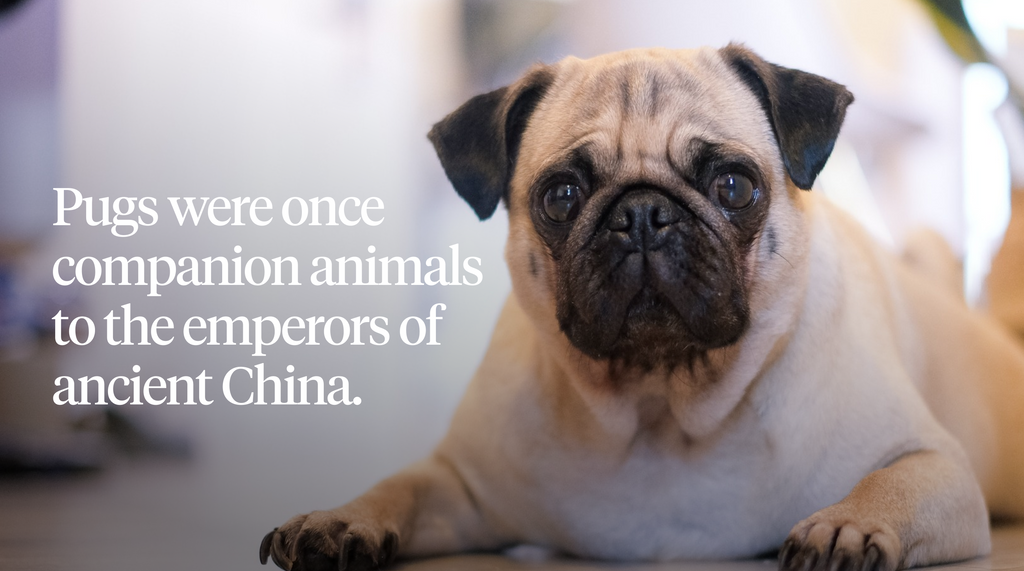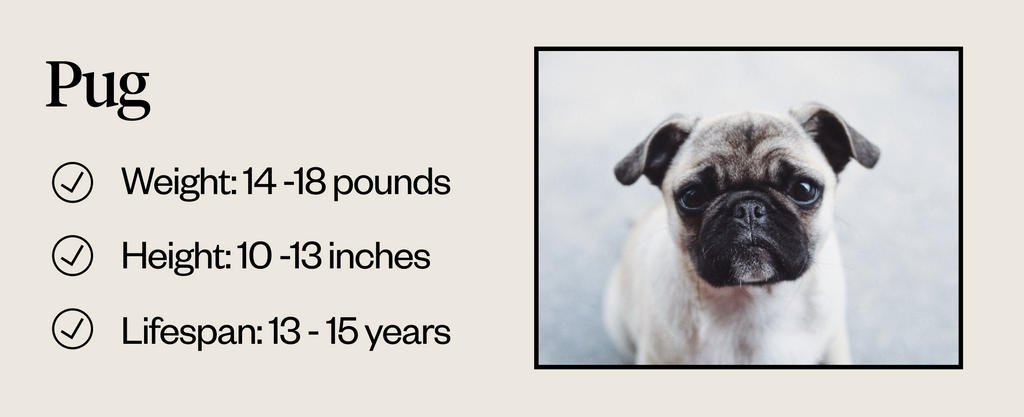11 Min Read
Pug: Pet Profile
Key takeaway

Why pet owners are switching to online vet care with Dutch
-
Prescriptions delivered free to you
-
Fast access to Licensed Vets over video
-
Unlimited video visits and follow-ups
Pugs, with their distinct appearance, have captured the hearts of many pet parents. These small yet sturdy dogs with wrinkled faces and a playful nature are known for their unique personalities. With roots dating back thousands of years, pugs have a rich history originating in ancient China.
However, pugs are most known for their compact bodies, short snouts, and wrinkled figure. With charming personalities that sets them apart, pugs are some of the friendliest dogs you’ll ever meet, and they often thrive on human companionship.
Keep reading to learn more about the pug, whether you’re a breed enthusiast or curious about whether a pug is the right pet for you.
- History & Origin of Pugs
- Physical Attributes of Pugs
- Behavioral Characteristics of Pugs
- Pug Health Risks
- Caring For a Pug
- FAQs
- Final Notes
History & Origin of Pugs
The pug is an ancient breed dating back to thousands of years ago in ancient China, where they were companion animals to emperors, living luxurious lifestyles.1 These dogs were regarded so highly, some had their own guards.
Like other breeds favored by emperors and the royal court, pugs were only acquired as gifts to outsiders. However, they eventually began making their way around the world. Dutch traders brought this breed to Holland and England.1

The American Kennel Club recognized the pug as a breed in 1885, and the Pug Dog Club of America was founded in 1931.1
Today, the pug is a popular pet for families with children and apartment dwellers. They make ideal apartment dogs because of their small stature and fun-loving yet gentle temperament. However, they’re also often good pets for families with children because they make excellent companions.
Physical Attributes of Pugs
- Weight: 14 -18 pounds
- Height: 10 -13 inches
- Lifespan: 13 - 15 years2
The pug is a toy breed with a distinct appearance. A short-haired dog, they have a double-layer coat in a variety of colors, ranging from black and fawn to silver fawn and apricot. These dogs are known for their flat faces and square bodies. Many pugs also have an underbite because of their facial structure, sometimes causing dental misalignments.

Behavioral Characteristics of Pugs
Pugs are companion animals that are often affectionate and playful. They’re often confident and active without being too much for first-time pet parents to rein in.3 Typically cheerful, pugs are generally accepting of strangers and other pets.3
They’re moderate barkers and make good watchdogs compared to other small breeds. However, they won’t typically serve as a protector because they often have a friendly nature.3
Still, pugs are often highly affectionate with family and can be great with children. They even typically accept other dogs, making them ideal for apartments or houses. It’s important to note that these dogs are highly playful, so they’ll need plenty of activities.
Luckily, pugs are typically easy to train and highly adaptable, and even though they’re playful, they’re not considered high-energy. However, like most dogs, they have mental stimulation needs. While they’re not couch potatoes, they don’t need as much physical or mental stimulation as other dogs, making them relatively easy to care for.2
It’s important to note that these are pug generalities. Every dog is different, regardless of their breed.
Pug Health Risks
Pugs are brachycephalic dogs, meaning they have short snouts and flat faces. This facial structure can cause breathing issues, including loud snoring and difficulty breathing.4 Pugs are also gassier than non-brachycephalic dogs because they tend to swallow more air.
Unfortunately, pugs are prone to various health issues, some related to being a brachycephalic breed. A study found that pugs are twice as likely to experience one or more disorders annually compared to non-pug breeds.5 A few health issues you should be aware of if you plan to adopt a pug include the following:
- Overheating: Dogs cool themselves by panting; they don’t sweat like humans do. Unfortunately, brachycephalic breeds like pugs have a small upper respiratory tract, forcing them to breathe through their mouths.4 Since pugs are unable to cool themselves as efficiently as other breeds of dogs, they’re prone to overheating.
- Breathing problems: Pugs are also prone to respiratory distress because of their narrow airways. Because it’s harder for them to breathe, pugs tend to breathe heavier and harsh breathing can cause their airways to collapse.4 This is why these pets are best for moderate climates. In addition, you should never overexert your pug with exercise since it can be dangerous for them.
- Allergies: Pugs are prone to allergies because they have narrow ear canals and facial folds that can collect allergens and bacteria.4 Many pugs are prone to ear infections and skin problems because of this. While there’s no cure for skin allergies, you can treat allergies to make your dog more comfortable.
- Dental disease: The brachycephalic face can also cause dental misalignment and other problems. While pugs have the same number of teeth as other dogs, they have smaller jaws, which can cause crookedness and crowding.4 These two seemingly aesthetic issues can increase the likelihood of food getting stuck in a pug’s teeth, eventually leading to plaque and tartar buildup and dental disease.
- Eye problems: Pugs have shallow eye sockets because of the structure of their faces, so their eyelids usually don’t completely close.4 Unfortunately, this makes the eye more prone to scratches, punctures, and popping out of the skull.
- Pug Dog Encephalitis (PDE): PDE, also known as necrotizing meningoencephalitis (NME), is a central nervous system disease that’s commonly fatal and affects 1.2% of pugs.6 It’s most commonly reported in female, fawn-colored pugs younger than seven years old. While rare, it’s a breed-specific disorder pet parents should be aware of because it causes brain inflammation and can lead to death. Treatment is primarily focused on making the dog as comfortable as possible.
Caring For a Pug
Pugs have the same basic needs as any other dog, with a few special considerations based on their potential for health issues.
- Preventive care: Preventive care is essential for all dogs but especially pugs, because they’re prone to a number of serious health conditions that can affect their quality of life. Unfortunately, flat-faced breeds like the pug can experience breathing issues, especially on hot days or in humid weather. Your vet will want to evaluate your pug for breed-specific issues every year to ensure their overall health. In addition, they’ll need annual diagnostics like heartworm and fecal testing to ensure they’re healthy.
- Grooming: Pugs have a short, smooth coat that doesn’t require too much maintenance. While these dogs shed, a weekly brushing can help remove loose hair. These dogs don’t need to be bathed often, either. However, they should have their nails trimmed regularly to prevent any discomfort.
- Exercise: Like all dogs, pugs require exercise. They’re neither lazy nor highly-active dogs, but they can be prone to weight gain. Walks are typically all you need to keep your pug in shape, but they can also burn off some extra energy in the yard. Of course, you should be careful never to over-exercise your dog. They should never do anything too strenuous because they have breathing issues.
- Nutrition: Pugs should eat high-quality dog food appropriate for their life stage. Since these pets can be prone to obesity since they love snuggling up on the couch all day, you should watch their food consumption.
- Training: Pugs love pleasing their pet parents, so they’re fairly easy to train. Early socialization and obedience training are ideal because they allow you to teach your dog about new people, places, and pets. In addition, you’ll get to work with a trained professional who can help you understand how to better communicate with your dog.
FAQs
Are pugs expensive?
Buying a pug from a breeder can cost a few thousand dollars because they’re highly regarded dogs. However, they’re also expensive because they require a lot of veterinary care. Because they’re prone to a range of health issues largely due to their facial shape, you can expect to visit the vet more often with this breed.
Are pugs a calm breed?
Pugs are playful but relatively calm. While they enjoy spending time on the couch, they also like activities like playing in the yard or going for a short walk.
Are pugs good pets?
Pugs are excellent pets because they were bred to be companion animals. They enjoy pleasing their owners and spending time with them. They’re also gentle with children and do well with other pets and people.

Final Notes
Pugs are fun-loving, gentle-natured pets that are excellent for families, apartment dwellers, and even the elderly. They’re also adaptable, so they’ll do well in the city, suburbs, or country. Unfortunately, pugs are prone to a variety of health issues that can affect their quality of life.
If your dog is prone to health issues, they’ll need to see the vet more often. Luckily, you may not need to go to in-person visits. Instead, you can talk to a Dutch vet online. Our vets can diagnose and treat a wide range of health issues in pugs to ensure your dog lives a happy, healthy life. Try Dutch telemedicine for pets today.
Share
References
-
“Pug History.” PUG DOG CLUB OF AMERICA, www.pugdogclubofamerica.com/pug-history.html.
-
Greenberg, Aurora. “Pug Dog Breed Information.” American Kennel Club, 6 Nov. 2017, www.akc.org/dog-breeds/pug/.
-
“Pug.” Encyclopædia Britannica, 30 June 2023, www.britannica.com/animal/pug.
-
Fassbaugh, Emily. “Pug.” PetMD, www.petmd.com/dog/breeds/pug.
-
“New Research Shows Pugs Have High Health Risks and Can No Longer Be Considered a ‘Typical Dog’ from a Health Perspective.” RVC, www.rvc.ac.uk/vetcompass/news/new-research-shows-pugs-have-high-health-risks-and-can-no-longer-be-considered-a-typical-dog-from-a-health-perspective.
-
“Genetic Marker Test for Pug Dog Encephalitis.” AKC Canine Health Foundation | Genetic Marker Test for Pug Dog Encephalitis, www.akcchf.org/canine-health/health-testing/spotlight-on-genetic-tests/genetic-test-for-pug-dog.html.

